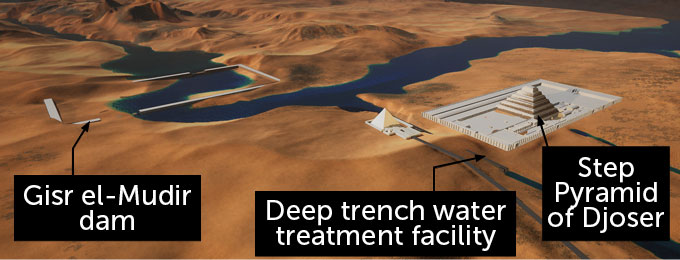Extreme Climate Survey
Scientific news is collecting readers’ questions about how to navigate our planet’s changing climate.
What do you want to know about extreme heat and how it can lead to extreme weather events?
The idea is intriguing, say researchers familiar with the study. But they are not convinced that the pyramid builders ever used such a device. Landreau, who has a background in materials science and plasma physics, founded Paleotechnic for the study of ancient technologies.
There is no generally accepted explanation for how the ancient Egyptians built the pyramids from millions of massive blocks. Those stones can weigh up to 2,500 kilograms each. Techniques proposed for maneuvering the building blocks of the pyramids include ramps, cranes, rope and pulley devices, and rotating wooden rods attached to the stones (SN: 9/9/14).
In a report published earlier this year, another research team described a newly identified, now dry, branch of the Nile bordering a chain of 31 pyramids, including Djoser’s. Ships containing workers and construction materials could have gone up this branch of the Nile to anchor near the sites where those pyramids were built some 4700-3700 years ago.
Water played an even bigger role in the construction of ancient Egypt’s first pyramid, says Landreau. He claims that the designers of Djoser’s pyramid ingeniously designed techniques for controlling the flow of water, a field of knowledge now known as hydraulics.
How the pyramidal hydraulic system might have worked
The proposed hydraulic system was derived from a computer model that included data on the surviving internal features of the pyramid and a network of underground tunnels at the site. The team also used high-resolution satellite imagery of the region’s landscape to model ancient rainfall and runoff levels.
In their model, a walled enclosure a few hundred meters from the pyramid—first described in the 1700s but still little understood—caught floodwaters that flowed through desert channels during periodic heavy rains. Structures in the enclosure walls, known as Gisr el-Mudir, directed water into a basin west of Djoser’s cemetery. Periods of intense rain may have temporarily turned that pond into a lake, which then drained into part of a limestone channel that surrounded the burial complex.
Scholars have previously proposed that the moat, known as the Dry Moat, served as a quarry for Djoser’s burial complex or as a model of the dead pharaoh’s path to the afterlife.

But Gisr el-Mudir and its nearby lake ensured that the Dry Moat wasn’t always dry in Djoser’s time, Landreau says. In the team’s model, water from the Dry Moat entered two large, previously excavated shafts, including a northern shaft located inside the pyramid. Granite chambers near the bottom of both shafts contained stone plugs that, when removed, allowed water to rush in.
The north shaft is the framework for a hydraulic elevator, the team proposes.
In this hypothetical structure, a massive wooden float stood above the granite chamber. The float was attached to two or more long ropes that passed over separate pulleys at the top of the shaft before being rotated to be attached to a lifting platform. Ancient engineers would have designed the floating and lifting platform to counterbalance each other when water fills or drains from the shaft, the researchers hypothesize.
Access points to the elevator platform for workers transporting building stones were located either at ground level or perhaps through a tunnel that could have been located several feet above ground level, Landreau’s team suspects.
As the water filled the shaft through the granite chamber, the float rose and the platform descended. The water was shut off when the platform reached the loading area. After placing thousands of stones on the platform, the shaft was drained. As the float descended, she pulled the ropes, taking the platform and its cargo up to new levels of construction.
Why the idea of pyramid plumbing may not hold water
That’s an unlikely scenario, says University of Toronto archaeologist Oren Siegel. Gisr el-Mudir could not have held enough water from occasional rains to maintain Landreau’s proposed hydraulic system, he argues. Gisr el-Mudir may instead represent an early experiment in the construction of stone enclosures that would later, on a larger scale, surround pharaoh burial sites, Siegel suggests.
Another complication involves the proposed lake, says Egyptologist Kamil Kuraszkiewicz: It is not mentioned in any ancient Egyptian writings and may never have existed.
Also, Djoser’s pyramid stones – which weighed an average of about 300 kilograms each – were significantly smaller and easier for workers to transport than those used for later pyramids, says Kuraszkiewicz, of the University of Warsaw. “To build the hydraulic device [proposed in the new model]it would take much more effort than moving blocks of stone using only manpower.”
Landreau calls for further research into Djoser’s pyramid. It is not known how high the partially excavated north shaft extended, limiting the ability to model a possible hydraulic lift system, he says. But he predicts that the stonework on the sides of the shaft would have supported a structure that rose beyond the known height of about four meters above the ground.
#Egypts #pyramid #built #plumbing #theory #hold #water
Image Source : www.sciencenews.org